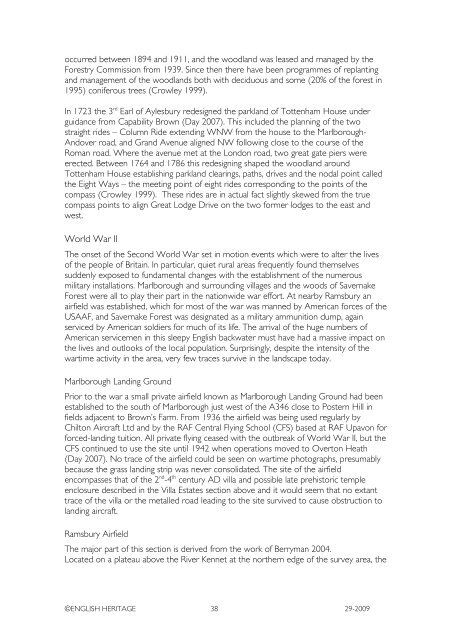savernake forest a report for the national mapping ... - English Heritage
savernake forest a report for the national mapping ... - English Heritage
savernake forest a report for the national mapping ... - English Heritage
You also want an ePaper? Increase the reach of your titles
YUMPU automatically turns print PDFs into web optimized ePapers that Google loves.
occurred between 1894 and 1911, and <strong>the</strong> woodland was leased and managed by <strong>the</strong><br />
Forestry Commission from 1939. Since <strong>the</strong>n <strong>the</strong>re have been programmes of replanting<br />
and management of <strong>the</strong> woodlands both with deciduous and some (20% of <strong>the</strong> <strong><strong>for</strong>est</strong> in<br />
1995) coniferous trees (Crowley 1999).<br />
In 1723 <strong>the</strong> 3 rd Earl of Aylesbury redesigned <strong>the</strong> parkland of Tottenham House under<br />
guidance from Capability Brown (Day 2007). This included <strong>the</strong> planning of <strong>the</strong> two<br />
straight rides – Column Ride extending WNW from <strong>the</strong> house to <strong>the</strong> Marlborough-<br />
Andover road, and Grand Avenue aligned NW following close to <strong>the</strong> course of <strong>the</strong><br />
Roman road. Where <strong>the</strong> avenue met at <strong>the</strong> London road, two great gate piers were<br />
erected. Between 1764 and 1786 this redesigning shaped <strong>the</strong> woodland around<br />
Tottenham House establishing parkland clearings, paths, drives and <strong>the</strong> nodal point called<br />
<strong>the</strong> Eight Ways – <strong>the</strong> meeting point of eight rides corresponding to <strong>the</strong> points of <strong>the</strong><br />
compass (Crowley 1999). These rides are in actual fact slightly skewed from <strong>the</strong> true<br />
compass points to align Great Lodge Drive on <strong>the</strong> two <strong>for</strong>mer lodges to <strong>the</strong> east and<br />
west.<br />
World War II<br />
The onset of <strong>the</strong> Second World War set in motion events which were to alter <strong>the</strong> lives<br />
of <strong>the</strong> people of Britain. In particular, quiet rural areas frequently found <strong>the</strong>mselves<br />
suddenly exposed to fundamental changes with <strong>the</strong> establishment of <strong>the</strong> numerous<br />
military installations. Marlborough and surrounding villages and <strong>the</strong> woods of Savernake<br />
Forest were all to play <strong>the</strong>ir part in <strong>the</strong> nationwide war ef<strong>for</strong>t. At nearby Ramsbury an<br />
airfield was established, which <strong>for</strong> most of <strong>the</strong> war was manned by American <strong>for</strong>ces of <strong>the</strong><br />
USAAF, and Savernake Forest was designated as a military ammunition dump, again<br />
serviced by American soldiers <strong>for</strong> much of its life. The arrival of <strong>the</strong> huge numbers of<br />
American servicemen in this sleepy <strong>English</strong> backwater must have had a massive impact on<br />
<strong>the</strong> lives and outlooks of <strong>the</strong> local population. Surprisingly, despite <strong>the</strong> intensity of <strong>the</strong><br />
wartime activity in <strong>the</strong> area, very few traces survive in <strong>the</strong> landscape today.<br />
Marlborough Landing Ground<br />
Prior to <strong>the</strong> war a small private airfield known as Marlborough Landing Ground had been<br />
established to <strong>the</strong> south of Marlborough just west of <strong>the</strong> A346 close to Postern Hill in<br />
fields adjacent to Brown’s Farm. From 1936 <strong>the</strong> airfield was being used regularly by<br />
Chilton Aircraft Ltd and by <strong>the</strong> RAF Central Flying School (CFS) based at RAF Upavon <strong>for</strong><br />
<strong>for</strong>ced-landing tuition. All private flying ceased with <strong>the</strong> outbreak of World War II, but <strong>the</strong><br />
CFS continued to use <strong>the</strong> site until 1942 when operations moved to Overton Heath<br />
(Day 2007). No trace of <strong>the</strong> airfield could be seen on wartime photographs, presumably<br />
because <strong>the</strong> grass landing strip was never consolidated. The site of <strong>the</strong> airfield<br />
encompasses that of <strong>the</strong> 2 nd -4 th century AD villa and possible late prehistoric temple<br />
enclosure described in <strong>the</strong> Villa Estates section above and it would seem that no extant<br />
trace of <strong>the</strong> villa or <strong>the</strong> metalled road leading to <strong>the</strong> site survived to cause obstruction to<br />
landing aircraft.<br />
Ramsbury Airfield<br />
The major part of this section is derived from <strong>the</strong> work of Berryman 2004.<br />
Located on a plateau above <strong>the</strong> River Kennet at <strong>the</strong> nor<strong>the</strong>rn edge of <strong>the</strong> survey area, <strong>the</strong><br />
©ENGLISH HERITAGE 38 29-2009

















